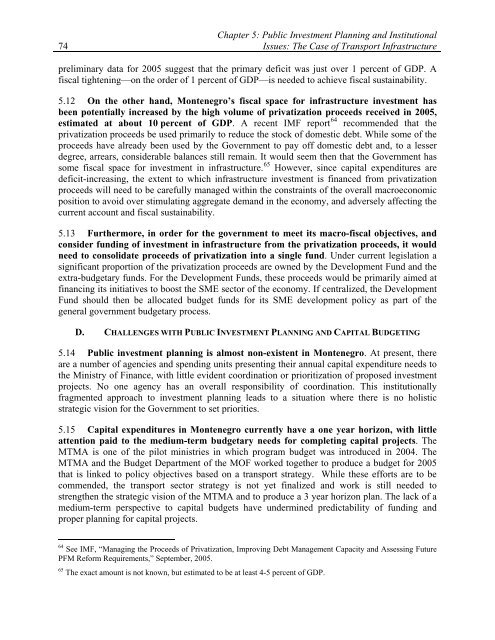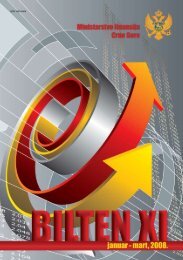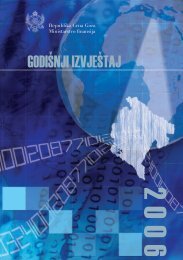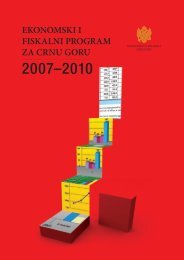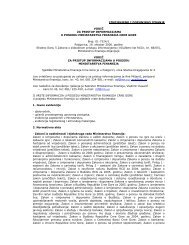Republic of Montenegro: Public Expenditure and ... - Vlada Crne Gore
Republic of Montenegro: Public Expenditure and ... - Vlada Crne Gore
Republic of Montenegro: Public Expenditure and ... - Vlada Crne Gore
You also want an ePaper? Increase the reach of your titles
YUMPU automatically turns print PDFs into web optimized ePapers that Google loves.
74<br />
Chapter 5: <strong>Public</strong> Investment Planning <strong>and</strong> Institutional<br />
Issues: The Case <strong>of</strong> Transport Infrastructure<br />
preliminary data for 2005 suggest that the primary deficit was just over 1 percent <strong>of</strong> GDP. A<br />
fiscal tightening—on the order <strong>of</strong> 1 percent <strong>of</strong> GDP—is needed to achieve fiscal sustainability.<br />
5.12 On the other h<strong>and</strong>, <strong>Montenegro</strong>’s fiscal space for infrastructure investment has<br />
been potentially increased by the high volume <strong>of</strong> privatization proceeds received in 2005,<br />
estimated at about 10 percent <strong>of</strong> GDP. A recent IMF report 64 recommended that the<br />
privatization proceeds be used primarily to reduce the stock <strong>of</strong> domestic debt. While some <strong>of</strong> the<br />
proceeds have already been used by the Government to pay <strong>of</strong>f domestic debt <strong>and</strong>, to a lesser<br />
degree, arrears, considerable balances still remain. It would seem then that the Government has<br />
some fiscal space for investment in infrastructure. 65 However, since capital expenditures are<br />
deficit-increasing, the extent to which infrastructure investment is financed from privatization<br />
proceeds will need to be carefully managed within the constraints <strong>of</strong> the overall macroeconomic<br />
position to avoid over stimulating aggregate dem<strong>and</strong> in the economy, <strong>and</strong> adversely affecting the<br />
current account <strong>and</strong> fiscal sustainability.<br />
5.13 Furthermore, in order for the government to meet its macro-fiscal objectives, <strong>and</strong><br />
consider funding <strong>of</strong> investment in infrastructure from the privatization proceeds, it would<br />
need to consolidate proceeds <strong>of</strong> privatization into a single fund. Under current legislation a<br />
significant proportion <strong>of</strong> the privatization proceeds are owned by the Development Fund <strong>and</strong> the<br />
extra-budgetary funds. For the Development Funds, these proceeds would be primarily aimed at<br />
financing its initiatives to boost the SME sector <strong>of</strong> the economy. If centralized, the Development<br />
Fund should then be allocated budget funds for its SME development policy as part <strong>of</strong> the<br />
general government budgetary process.<br />
D. CHALLENGES WITH PUBLIC INVESTMENT PLANNING AND CAPITAL BUDGETING<br />
5.14 <strong>Public</strong> investment planning is almost non-existent in <strong>Montenegro</strong>. At present, there<br />
are a number <strong>of</strong> agencies <strong>and</strong> spending units presenting their annual capital expenditure needs to<br />
the Ministry <strong>of</strong> Finance, with little evident coordination or prioritization <strong>of</strong> proposed investment<br />
projects. No one agency has an overall responsibility <strong>of</strong> coordination. This institutionally<br />
fragmented approach to investment planning leads to a situation where there is no holistic<br />
strategic vision for the Government to set priorities.<br />
5.15 Capital expenditures in <strong>Montenegro</strong> currently have a one year horizon, with little<br />
attention paid to the medium-term budgetary needs for completing capital projects. The<br />
MTMA is one <strong>of</strong> the pilot ministries in which program budget was introduced in 2004. The<br />
MTMA <strong>and</strong> the Budget Department <strong>of</strong> the MOF worked together to produce a budget for 2005<br />
that is linked to policy objectives based on a transport strategy. While these efforts are to be<br />
commended, the transport sector strategy is not yet finalized <strong>and</strong> work is still needed to<br />
strengthen the strategic vision <strong>of</strong> the MTMA <strong>and</strong> to produce a 3 year horizon plan. The lack <strong>of</strong> a<br />
medium-term perspective to capital budgets have undermined predictability <strong>of</strong> funding <strong>and</strong><br />
proper planning for capital projects.<br />
64 See IMF, “Managing the Proceeds <strong>of</strong> Privatization, Improving Debt Management Capacity <strong>and</strong> Assessing Future<br />
PFM Reform Requirements,” September, 2005.<br />
65 The exact amount is not known, but estimated to be at least 4-5 percent <strong>of</strong> GDP.


